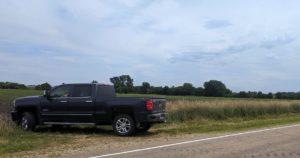Farming has changed dramatically over the years, with bigger equipment, more technology and recently wetter springs. Brian, a LaSalle Co. farmer, says, “everything is a lot different this year. Can’t sit around thinking ah tomorrow will be better, you just don’t know anymore. When it’s go time, you’ve got to go.”
All of these changes have shortened the window of time farmers have to get their crops in the field, making speed and efficiency top priorities for farmers. However, Brian says a big concern of his is keeping his soil in his fields and out of the ditch. He says he does “different practices to keep it (the soil) from moving, try not to work areas that are wash areas and try to put the dirt back where it should be and it’s a hard thing sometimes.” Despite these challenges, protecting his soil is important for the long term productivity of his farm.

As a seed corn farmer he plants two types of corn next to each other, where one will pollinate the other to produce a hybrid of the two. He found that he could replace his pollinating rows with cover crops after they’d done their job. This gives his cover crops more time to grow before winter hits. This gave them a head start. “It seems the headlands were getting harder and harder and pack easier, so we ended up after we mowed them down, we planted cover crops in the headlands, it keeps the weeds down, something’s growing there, and then it adds some more organic matter.”
Keeping Soil on the Land Since the 80s
Brian’s family started finding ways to keep the soil in place back in the 80s when his dad first started putting in terraces and waterways. These berms and grass strips help slow the water as it moves over the soil so that it has more time to infiltrate, deposing soil particles and nutrients before it leaves the field. Since then, they’ve put in many more waterways and filter strips to keep their soil on the land.
The LaSalle Co. SWCD and NRCS staff helped with the original waterways. However, the program rules can sometimes make it difficult to qualify even if there is a resource concern. Brian found he could only enroll filterstrips next to an open body of water. However, where he had a ditch with a huge culvert draining directly into the creek didn’t qualify. In the end, he went ahead and put his own filterstrip in next to the ditch to keep his soil from washing away.
While the programs can sometimes get caught up with bureaucratic rules, this is a great example about how supporting farmers when they are first learning new practices that protect soil and water can give them a safer way to explore the costs and benefits of various conservation practices. With that knowledge they are able to decide when and where it is worth it to invest in these practices on their own dime.
“I know it keeps my dirt in place.”
In the end, experience is the best teacher, and this LaSalle Co. Farmer says he uses conservation farming practices because, “I know it keeps my dirt in place.”







